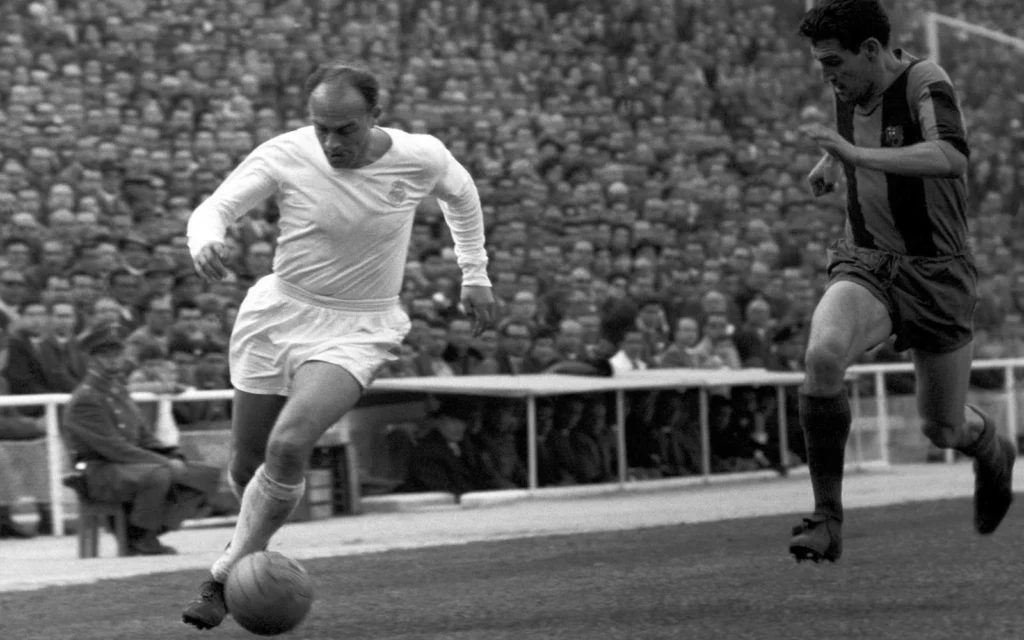
Alfredo Di Stefano
What transpired during this time was more than just club success; it was the evolution of Di Stefano as a player. He matured into a leader, guiding his teammates and inspiring them to perform at their best. His experience in Colombia further expanded his football IQ, setting the stage for an even more remarkable chapter in his career https://king88.dad/.
Real Madrid Era The Golden Years Alfredo Di Stefano
The pinnacle of Alfredo Di Stefano career arrived when he signed with Real Madrid in 1953. However, the circumstances surrounding his transfer were shrouded in controversy and rivalry, reflecting the high stakes involved in European football at the time.
How He Joined Real Madrid and the Controversy Around It
The pursuit of Alfredo Di Stefano was fraught with tension. Barcelona initially negotiated for him, leading to heated debates between the two clubs. Ultimately, a compromise was reached, allowing Di Stefano to join Real Madrid amid a backdrop of heated rivalry. The negotiation saga only heightened expectations regarding his potential impact at the club.
Once he arrived at Madrid, the transformation began almost immediately. Di Stefano’s presence injected life into the team, establishing a standard that would soon propel Real Madrid to unprecedented heights. He became the heart and soul of the squad, blending seamlessly with other star players like Francisco Gento and Ferenc Puskas.
His Role in Shaping Real Madrid’s Dominance
Under Di Stefano’s guidance, Real Madrid turned into a formidable force in European football. His ability to score, assist, and defend reshaped the team’s dynamics and tactics. He played a crucial role in Madrid’s dominance of La Liga and the nascent European Cup, which would later become known as the UEFA Champions League.
During his illustrious career at Real Madrid, Di Stefano led the club to a staggering number of titles, marking the beginning of an era that would see Los Blancos regarded as one of the premier football clubs globally. His tactical flexibility allowed him to adapt to different formations, evolving alongside the strategies employed by various managers.
Di Stefano’s impact extended beyond the pitch—he became a symbol of excellence, embodying the club’s values and aspirations. Fans idolized him, and he formed a deep bond with the supporters, leaving a legacy that continues to resonate today.
Key Achievements: European Cup Victories, League Titles
Throughout his decade-long stay at Real Madrid, Di Stefano accumulated a wealth of silverware. He was integral to the team’s triumphs in the European Cup, contributing significantly to their unprecedented run of five consecutive titles from 1956 to 1960.
His scoring feats were astounding, as he netted goals in crucial matches, securing victories against Europe’s elite clubs. Di Stefano’s sheer determination on the field often turned games around, proving that he was not just a player but a game-changer.
Beyond Europe, he helped lead Real Madrid to multiple La Liga titles, solidifying their position as Spain’s dominant football institution. His contributions to the club transcended statistics, showcasing the qualities of leadership, skill, and passion that defined his legacy.
Playing Style and Influence on Football
One of the most compelling aspects of Alfredo Di Stefano‘s legacy lies in his unique playing style. His blend of technical finesse and tactical awareness positioned him as a pioneer in how the forward role could be interpreted and executed.
Unique Skills, Tactical Intelligence, and Versatility
From his early days through to his prime, Di Stefano exhibited a range of skills that were ahead of his time. His dribbling ability was matched only by his exceptional passing, allowing him to create opportunities not just for himself but also for his teammates.
What truly set him apart, however, was his tactical intelligence. Di Stefano had an innate understanding of the game, regularly positioning himself in spaces that maximized his team’s chances. He could drop deep to retrieve the ball, set up plays from midfield, or exploit defensive gaps in the opposition’s backline.
Versatility was perhaps his greatest asset. Di Stefano could play as a traditional center-forward, a second striker, or even a midfielder, seamlessly transitioning between roles depending on the tactical needs of the team. This adaptability made him a nightmare for defenders, as they struggled to predict his movements and anticipate his next moves.
Influence on Modern Football Tactics and Playing Styles
Alfredo Di Stefano‘s impact on football tactics is profound and enduring. Many modern coaches and analysts point to his playing style as a precursor to the ‘false nine’ concept we see in contemporary football. His ability to vacate traditional attacking positions to draw defenders out of position opened up space for other players to exploit, a tactic that is now foundational in many top teams’ strategies.
Additionally, Di Stefano’s emphasis on teamwork and collective play highlighted the importance of collaboration over individualism in football. His selfless approach inspired future generations to prioritize team success above personal accolades, fostering a spirit of unity that remains crucial in today’s game.



